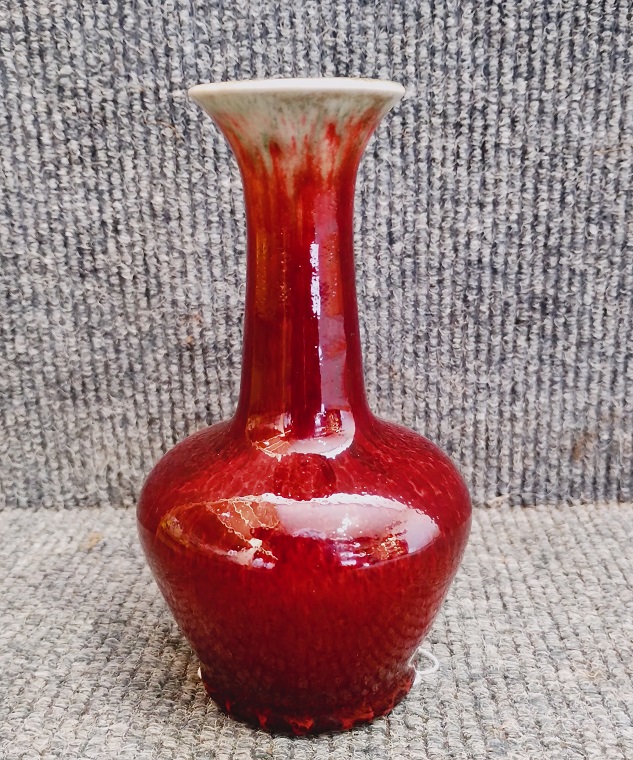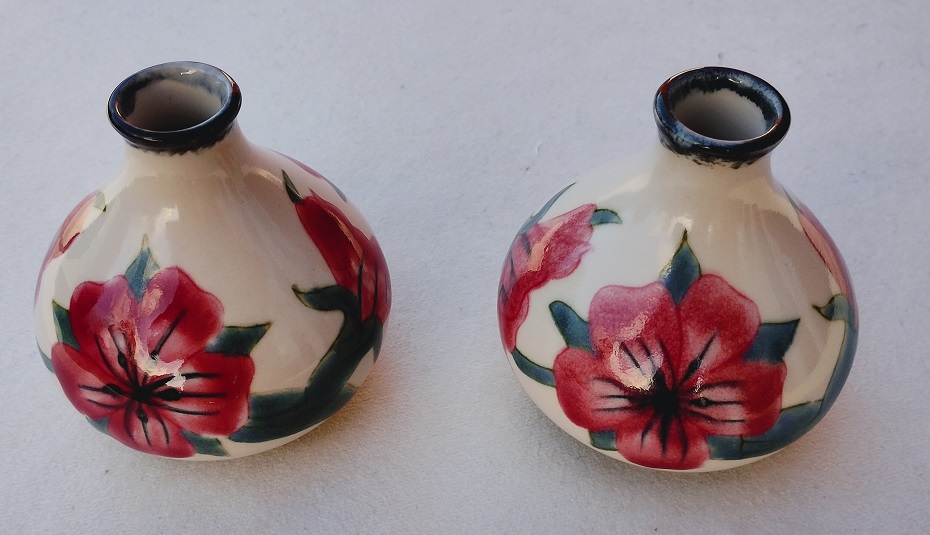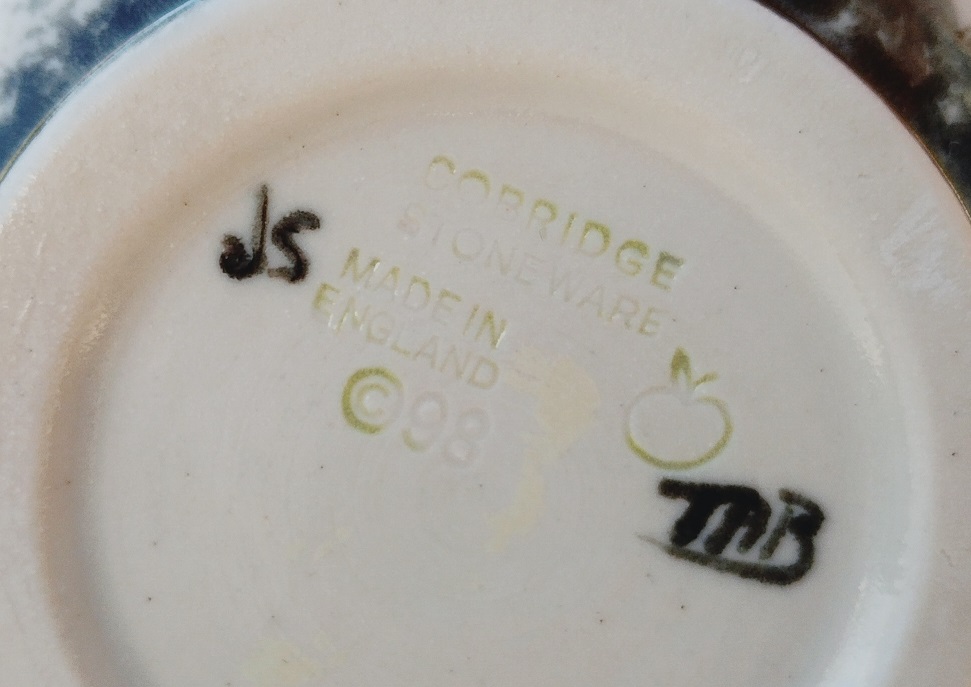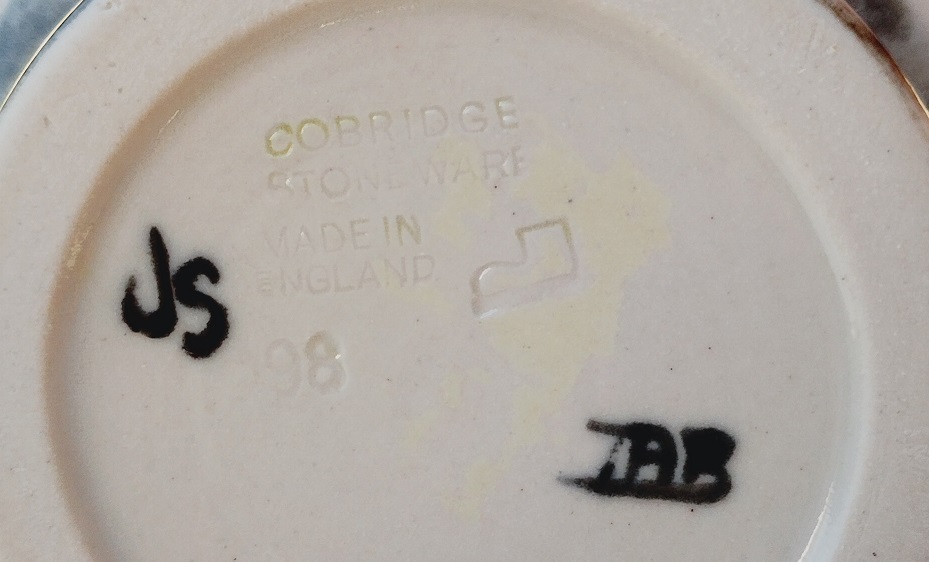At a recent antiques fair, I met a collector who explained to me the date cyphers to be found on Cobridge pottery. Having had a look around the internet there doesn’t seem to be much on the subject so I will attempt to put this right with this short posting.
Cobridge Pottery

A small but beautifully glazed Cobridge Sang de Boeuf vase. Exactly the sort of item the pottery was set up to create.
Cobridge Pottery was something of a failed experiment that lasted just seven years. The company was created as an offshoot of the much more famous Moorcroft Pottery in 1998. Cobridge was always intended to be experimental with one of its aims being to try to recreate the high temperature fired ceramics known from the Ruskin Pottery between about 1900 and 1935. The processes used at Ruskin have never been successfully reproduced and the secrets behind them remain just that – secret.
From the outset Cobridge was popular with collectors of art ceramics, not surprising given the quality of the early pieces in particular. Collectors seem to view the later produce as less inspired so in general it’s the earlier work that gets the most interest.
The separation of the Cobridge name from Moorcroft was, at least in part, about marketing as the types of ceramics produced were very different. It allowed the Moorcroft name to remain solely associated with the familiar tube-lined work. Nonetheless, the same Moorcroft designers and artists were employed to produced work for Cobridge. I’ve been told it was a case of when artists from Moorcroft were free of immediate Moorcroft work they went down the road to the Cobridge factory and worked there instead. Names familiar to Moorcroft collectors such as Andrew Hull, Anita Harris, Philip Gibson, Kerry Goodwin and Nicola Slaney all worked at Cobridge at some time.
As with Moorcroft, there was a Cobridge Collectors Club. When joining for the first time, members received a small squat vase decorated with Corncockle flowers. These attractive little vases are a familiar sight around antique fairs today at a frequency which suggests the Collectors Club was very popular at the time.

A pair of the Cobridge Corncockle vases
Dating Cobridge Pottery
As with modern Moorcroft produce, Cobridge Pottery pieces can be dated by looking for what’s called a date cypher. This is a small figure or drawing on the base. This figure is under the top glaze and so can not be interfered with after production. With a reference chart (or a good memory) you can tell the year in which a piece was produced.

The base of a Cobridge Corncockle vase showing the full range of markings typically found. The Date Cypher here is the apple, indicating 1998 which matches the Copyright year.
You might wonder why not just write the date on the base? There’s a story related in the biography of Sir Henry Doulton by Edmund Gosse that might explain it. When Doulton Pottery (later Royal Doulton) began producing art ceramics in the mid-1870s they stamped the base of their work with the year of production. However, when these were put into shops, buyers didn’t like buying what they felt was a previous year’s design, so the practise was stopped. In the case of Doulton this is a cause of frustration for collectors. Dating individual pieces of Doulton ceramics is often difficult and it’s rare to be able to pin a specific year to a piece.
As mentioned above, Cobridge Pottery production ran for seven years, between 1998 and 2005. The date cyphers are alphabetically ordered which makes remembering them easier. The cyphers (with thanks to Suzanne Pickup for the 2005 cypher) are:
- Apple 1998
- Boot 1999
- Crown 2000
- Duck 2001
- Egg (cup) 2002
- Fern 2003
- Grapes 2004
- Holly 2005
If you’re interested in dating Moorcroft Pottery, the best online reference I know of is provided by the very excellent Potteries Auction web site: https://www.potteriesauctions.com/news/moorcroft-pottery-markings-guide. As with Cobridge. Moorcoft date cyphers are also alphabetically ordered starting with an Arrow in 1990 and reaching a “Z” in 2015. They started a new sequence in 2016 with an Anchor. Prior to 1990, only imprecise dating is usually possible.
Date Cyphers and Copyright years

As above, the base of a Cobridge Corncockle vase, but this time showing a date cypher of a Boot, for 1999 along with the Copyright year of 1998.
As I mentioned in a previous posting with respect to a piece of modern Moorcroft pottery, there is the chance of confusion between the year that the date cypher indicates and a Copyright year. The difference is that the copyright year relates to the year the design was created whilst the date cypher relates to the year of manufacture. In the case of a design used over multiple years you can find a design with different date cyphers but the copyright year should always be the same. This is shown nicely in the Cobridge Corncockle vase base in the above image. The design was created in 1998, the year Cobridge came into being but the vase was created across multiple years.
Hello
The mark for 2005 beginning with H is holly.
Thank you. I have updated the list.